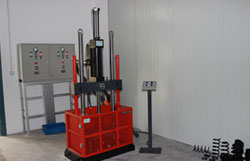Research & Development Equipment of the Pipe, Tube and Bar Steel Technology Center
The Pipe, Tube and Bar Steel Technology Center is equipped with dedicated equipment for research, development and testing of pipe, tube and bar steel products. It has equipment for sample preparation, metallographic phase and hardness testing, tubing and casing thread machining, physical performance, hydrogen sulfide and carbon dioxide corrosion, fatigue of wire rod and cold heading. It can conduct metallographic phase and hardness tests on materials, full-size physical performance tests on steel pipes and tubes, collapse resistance tests on tubing and casing, hydrogen sulfide stress tests, and carbon dioxide corrosion tests. It can also conduct performance tests regarding fatigue, torque and cold heading of wire rod products for auto parts.
-
Sample Preparation
Laboratory -
Physical Testing
Laboratory -
Tubing and Casing
Processing and Testing Center -
Hydrogen Sulfide
Corrosion Laboratory -
Bar and Wire Rod
Performance
Testing Laboratory
- Spring fatigue testing machine
- Spring steel wire rotating bending fatigue test machine
- Galvanized steel wire torsion test machine
Spring fatigue testing machine

The spring fatigue testing machine's working distance: 0-800mm; indenter amplitude: ¡À 200mm; frequency: 0.1-5Hz (when the amplitude is ¡À 105mm, the frequency can reach 2Hz); maximum dynamic and static load: 50kN; with imported displacement sensors, displacement measurement accuracy is 1%. It can be used for fatigue life tests of automobile suspension springs with an outer diameter of no more than 185mm under different stress amplitudes.
Spring steel wire rotating bending fatigue test machine

The test machine can perform rotary fatigue life tests by applying a certain bending moment to the straight-bar spring wire sample via the motor. Specifications of samples that can be tested: ¦µ8-20mm; adjustable working distance between two chucks: 500 ~ 1600mm; axiality between two chucks ¡Ü0.013mm; maximum tensile stress of steel wire surface: 1500MPa (stress can automatically loaded via the servo motor); rotational frequency: 5 ~ 50Hz.
Galvanized steel wire torsion test machine

The galvanized steel wire torsion test machine can be set with various approaches, including stepless speed regulating, rotating speed, number of turns, and torsion mode. It can be used to test the resistance of wire rods to plastic deformation when subject to single- or double-way torsion and indicate surface and internal defects of wire rods. Diameter range of wire rods to be tested: ¦µ3 ~ ¦µ7mm; maximum distance between two chucks: 700mm; operating noise <70 dB.
